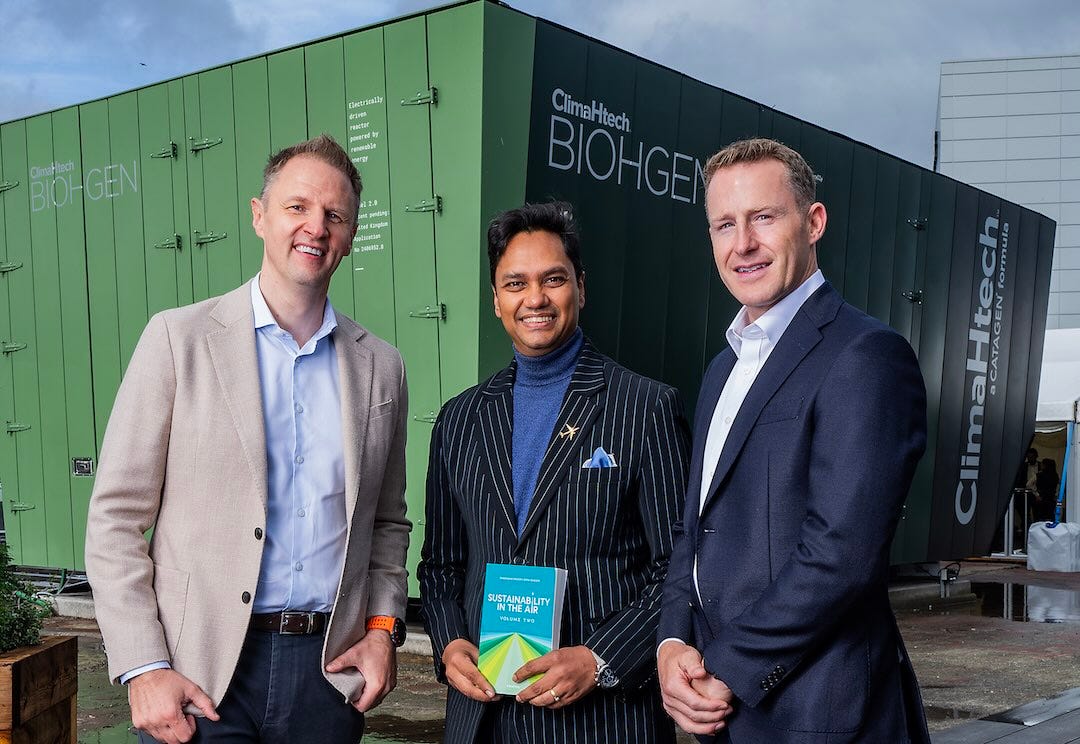Catagen launches ClimaHtech Green Flight with landmark SAF deal
Backed by Ryanair and Shell Aviation Ireland (MJV), Catagen takes SAF innovation to market.
Belfast’s Titanic Quarter was the stage for a landmark moment in aviation’s decarbonisation journey, as local green tech firm Catagen unveiled its new subsidiary, ClimaHtech Green Flight (CGF). The launch saw the signing of a multi-year offtake term sheet for sustainable aviation fuel (SAF) involving two industry heavyweights: Ryanair and Shell Aviation Ireland (MJV).
The centrepiece came during a panel led by SimpliFlying CEO Shashank Nigam, when Catagen CEO Dr Andrew Woods stepped on stage to reveal a surprise:
In his hand was a signed term sheet committing Ryanair and Shell Aviation Ireland (MJV) to offtake SAF from Catagen’s first-of-a-kind project. “It’s a multi-year agreement and we’re delighted to have the endorsement of both partners,” he told the audience.
Shashank Nigam then guided a discussion between executives from Ryanair, Shell Aviation Ireland, VINCI Airports and ClimaHtech Green Flight on how decentralised SAF production could redefine aviation fuel supply.
A decentralised model for SAF
Catagen’s patented modular reactor technology challenges the traditional paradigm of billion-dollar, centralised refineries that take a decade to build. Instead, ClimaHtech Green Flight aims to deploy factory-engineered, decentralised units near renewable energy sources or airports, each capable of producing up to 10 million litres of SAF annually.
Crucially, the system is designed to harness off-grid renewable electricity, wind, solar, or other low-carbon sources, and convert it into high-quality synthetic fuel. By “scaling out” with multiple smaller units rather than relying solely on vast central plants, Catagen seeks to cut costs, reduce risk, and bring production closer to where fuel is actually needed.
Mel Courtney, CEO of ClimaHtech Green Flight, described the moment as a transition from proof-of-concept to commercialisation. “From what you see today, which is very real, to the next stage, which is fully commercialised. That’s the journey we are now on,” he told the Belfast audience.

Industry leaders weigh in
Ryanair’s sustainability director, Steven Fitzgerald, said the decentralised model was especially attractive for airlines flying to smaller airports across Europe. By locating production next to renewable energy, he explained, Catagen can “connect demand with supply in a way that doesn’t exist with the centralised model.”
Shell Aviation Ireland’s Ken McHutcheon stressed the significance of producing fuel locally: “It’s probably the most exciting thing I’ve seen in my time in aviation, something that can finally be done on the island of Ireland, producing fuel to ASTM 7566 standard and getting it to a wingtip.”
From the airport perspective, Germain Hurtado of VINCI Airports pointed to Catagen’s feedstock as reliable and widely available, and noted that airports with their own renewable generation could integrate such decentralised units as part of a broader push to net zero.
Throughout the discussion, Shashank Nigam drew the threads together, linking Belfast’s story to wider global trends. He argued that decentralised models “dramatically bring down the technology risk” compared with many SAF mega projects still struggling to reach a final investment decision.
He also reflected on the policy shift that made the Belfast launch possible: “The one big thing that has changed in just a year is how the UK has moved from debate to delivery. It’s already showing results - supporting startups, giving airlines revenue guarantees, and building a real ecosystem. That’s a model others are now watching.”
A Belfast story with global resonance
The launch positions Belfast as more than a local success story. As Catagen CEO Dr Andrew Woods explained, the aim is not just to pilot a new technology but to “scale a network of decentralised production units worldwide.”
With Ryanair and Shell Aviation Ireland (MJV) committing to offtake, ClimaHtech Green Flight signalling rapid rollout, and local and international airports interested in hosting future deployments, the city’s Titanic Quarter may soon become a key proving ground for the fuels that will power aviation’s next chapter.
Closing the session, Nigam summed up the bigger picture. While Belfast was the immediate focus, he said the model could serve as “a blueprint for how aviation fuels itself in the future, faster, smarter, and closer to where the demand is.”


